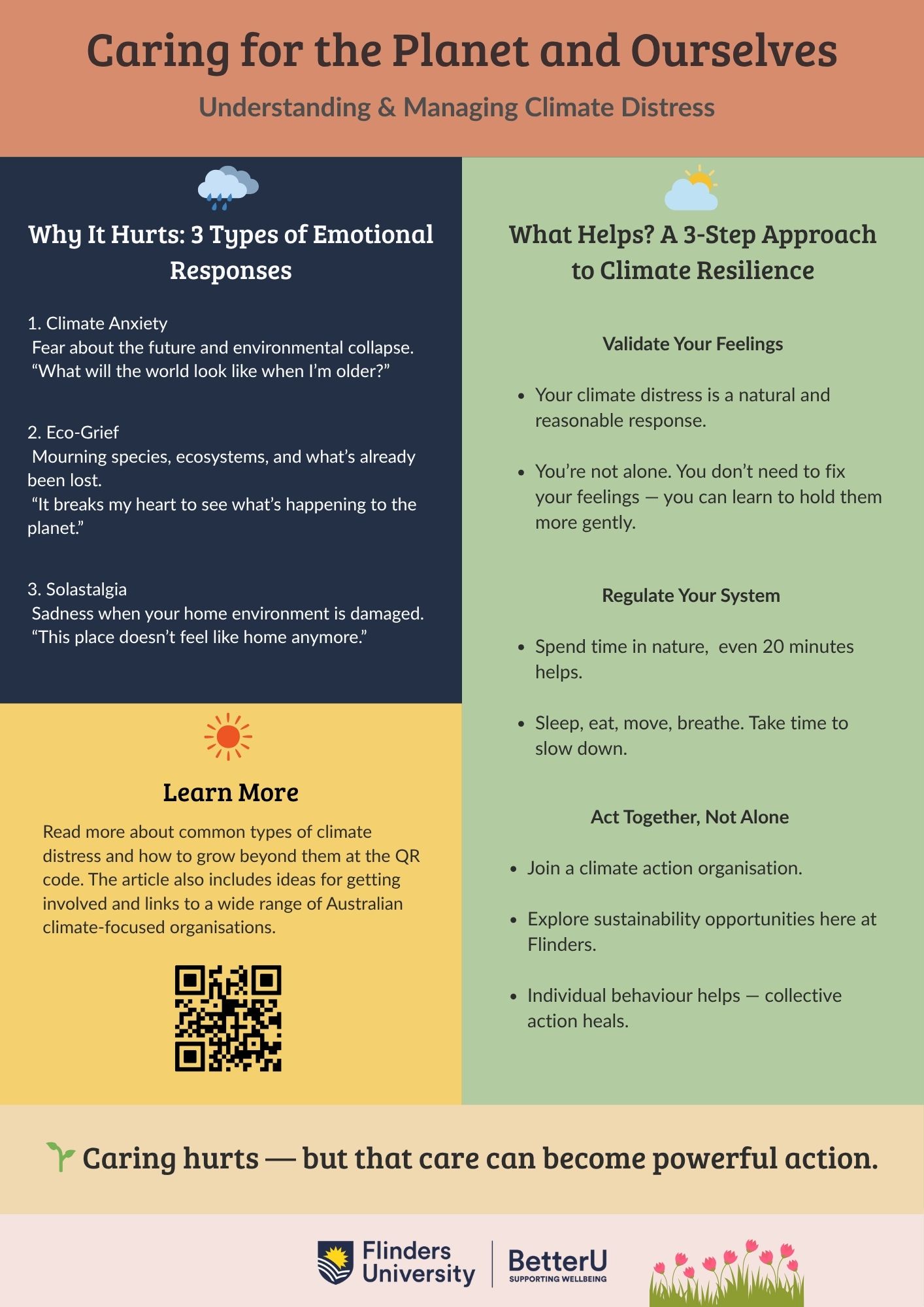
Climate distress is a rational response to an irrational situation, and through connection, care, and collective action, we can turn overwhelm into momentum.
Climate Week is coming to Flinders, and with it a chance to talk about something that’s increasingly on my mind at least (and I suspect on many), climate distress.
Properties, Facilities and Development (PFD) are planning some Sustainability Week activities at the Bedford Park and City Campus from the 2nd to 4th September.
They put out the call to us at BetterU and Oasis to see if we’d like to be involved. Why thank you. I will!
I thought it was a good opportunity for me to update myself on the topic of climate anxiety.
You see, climate change doesn’t just affect the environment, it (not surprisingly) affects those of us living in that environment. The damage we’re seeing across ecosystems, species, and weather systems has real psychological consequences.
I know that I often feel overwhelmed, heartbroken, anxious, or just deeply unsettled by it all and the literature would suggest that this is the case for many young people (and I am sure many in my age bracket and older as well). I’ve even written about it before.
I’ve developed a few ways to work with that distress myself (with more still to learn), but I wanted to write about the topic with the hope that those of you who feel distress about climate-related issues might gain insights into how to manage it for yourself.
It’s not just anxiety — and it’s not a disorder
‘Climate anxiety’ is the most commonly used term to describe distress arising from climate change, but it probably isn’t the best term (see some others below). In my world (psychology), the term anxiety is generally used as a clinical term, applying to specific types of mental illness or disorders.
But the general consensus in psychology at the moment is that climate-related distress is not a mental illness – it is arguably a healthy response to an unhealthy situation. Feeling anxious, sad or angry about the state of the planet and how we treat it is not pathological, it’s logical!
Secondly, the term ‘climate anxiety’ implies that anxiety is the primary emotion/feeling. But we know that climate distress can take many forms: worry, fear, sadness, anger, helplessness, betrayal, just to name a few.
The distress is real though. And it can affect your mood, your concentration, your sleep, your work/study and your sense of hope for the future. So, it’s worth understanding better and working out how to address it.
But rather than making it an issue related to the individual (i.e. something is ‘wrong’ in them that needs treating), the current view is that we should approach it as a collective, namely channelling that distress into collective action.
So instead of asking “what’s wrong with me?”, we might ask “what does this distress want me to know, and where could it take me?”
Climate distress comes in different forms
Researchers have identified at least three major types of climate-related emotional pain:
-
Climate anxiety — worry or fear about the future and what lies ahead
-
Eco-grief — mourning what has already been lost: species, forests, clean air
-
Solastalgia — sadness when your home environment changes in unsettling ways
And climate distress isn’t just experienced as emotions or feelings. It can show up as:
-
Emotions – guilt, despair, anger, sadness, helplessness, numbness
-
Thoughts – intrusive worries, catastrophising, obsessive information seeking
-
Behaviours – avoidance, doomscrolling, withdrawal, activism burnout
-
Somatic (body) symptoms – disrupted sleep, fatigue, stomach aches, restlessness
Managing climate distress therefore, involves tackling all of these. One particularly interesting aspect of climate distress is the behavioural component.
The paradox of caring
One paradox that has been noted in the literature is that those who experience significant climate distress can show quite opposite reactions/behaviours.
Sometimes, caring deeply about the planet can energise or motivate someone. This is the person who, after learning about climate science, feels emboldened to act. They might make some personal changes, join groups, donate money to climate causes or other proactive responses.
Other times, it leads to shutdown or despair. Overwhelmed by the size or scope of the problem or their thoughts about it, some individuals become paralysed and may take steps to avoid or distance themselves from the topic altogether.
So why does one person take action while another feels paralysed?
A key factor appears to be agency – the belief that your actions can make a difference. A key shift for me was when I learned that I could donate to groups who were taking specific action on climate issues. A small action on my part could meaningfully lead to action.
Interestingly, agency seems to grow more powerfully in collective contexts. That’s why joining with others is often a better antidote to despair than trying to “go it alone.” This doesn’t negate the changes that an indivdual might make (changes to their diet, improving their recycling behaviour, choosing public transport etc), but it says that these changes might not motivate and sustain that person as well as joining with others to take action.
It’s often connection, not just personal commitment, that keeps us going.
A 3-part approach to managing climate distress and building climate resilience
If you find yourself quite debilitated by climate distress, I do recommend having a chat to a mental health professional. Not because you are ‘ill’ for feeling that way, but because climate distress can affect our thinking and behaviour in ways that get us stuck and therapy/ counselling is a great antidote to being stuck.
Whether you get that formal assistance or not, you don’t need to be an expert, an activist, or a changemaker to make meaningful inroads to managing that distress yourself. Here’s a simple, research-informed framework:
✅ 1. Validate Your Feelings
Remind yourself regularly that your distress is a normal and rational response to what’s happening.
You don’t need to get rid of it. On the contrary, you can learn to sit with it, talk about it, and channel it.
🌿 2. Regulate Your System
Even though the distress is a normal and rational response, it will still have an impact on your body and mind and does need to be managed.
That is where good self-care comes in. Try:
-
Spending time in nature (it is the thing you are trying to save and may well save you)
-
Sleeping, eating, moving, connecting (the usual healthy lifestyle practices will provide the necessary energy to take on the challenge)
-
Taking breaks from the news (cultivate an information diet that still keeps you informed but is perhaps more balanced)
-
Breathing practices or mindfulness (explore specific practices of body and mind that are restful or calming)
- Seeking help (if the feelings are too big to handle or you’d like some more advanced mental health self-care techniques)
To be clear, these aren’t solutions to climate change. They’re supports for your nervous system while you stay engaged. You can check out our self-care mega guide if you want more suggestions.
🤝 3. Act Together, Not Alone
The most powerful antidote to despair? Doing something with others.
That might mean:
-
Sharing your concerns with a friend or group (find a climate buddy and perhaps decide on an action you can take together)
-
Attending a local sustainability event (which if you remember was the trigger for this article in the first place)
-
Volunteering with a climate organisation (I’m naturally quite lazy so I donate instead)
-
Starting or joining a student initiative (I am surprised there isn’t a nature focused student club yet, perhaps you’ll be the one to start it)
Individual behaviour helps — but collective actions seems the more sustaining.
Want to take action?
With action in mind, here are a few places you can get started. If you’re ready to do something — big or small — there are many options.
-
🌐 Explore Australian climate-focused organisations as a way to connect with the climate movement
-
🌿 Ask the Flinders sustainability team about student projects and events
- 🌲Participate in Sustainability Week at Flinders
-
🎨 Channel your care into something creative — a poster, a zine, a story, a walk. If you’ve been reflecting on your own connection to nature, or want to write about how you’re navigating climate distress, we’d love to share your story on the BetterU blog. Email me at gareth.furber@flinders.edu.au to talk it through.
Focus on what you can do, with who you’ve got, where you are.
Oh, and you might see this infographic floating around during Sustainability Week.


